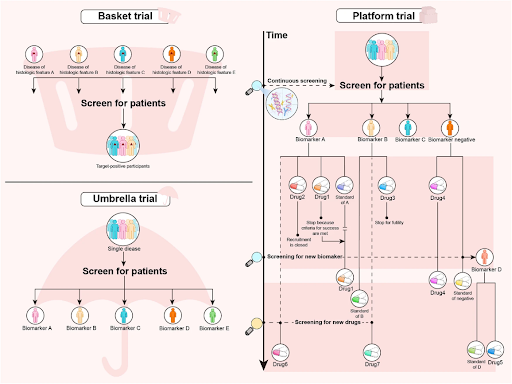Next-Generation Sequencing Driving Innovative Approaches in Clinical Trial Designs
Basket, umbrella and platform trials are innovative approaches to clinical trial design that aim to improve the efficiency and effectiveness of testing new treatments. They differ from conventional clinical trials by offering more flexibility in testing multiple therapies or targeting different subgroups of patients simultaneously. Traditionally, clinical trials focused primarily on tumor histology, which led to a one-size-fits-all treatment approach. However, with the advent of next-generation sequencing (NGS), the focus has transitioned from histological characterization to molecular profiling. NGS plays a crucial role in driving these innovative clinical trials by identifying molecular profiles that can be used to guide treatment decisions, enhance patient selection, improve patient safety, and optimize patient outcomes.
-
Basket trial: A clinical trial design that tests a single therapy across multiple cancer types or patient populations that share a common biomarker or genetic mutation, regardless of tumor’s origin. Instead of recruiting only patients with a specific type of cancer, patients with different types of cancer (e.g., breast cancer, lung cancer, colorectal cancer) who share a common genetic alteration (e.g., HER2 amplification, KRAS mutation), are grouped together, speeding up the recruitment process. Testing a single therapy in multiple cancer types enables more efficient resource utilization by reducing duration and cost, compared to conducting separate trials for each cancer type. This trial design allows faster identification of genetic alterations that are predictive of treatment response across multiple cancers, potentially broadening access for this new therapy.
-
Umbrella trial: A clinical trial design in which different therapies are tested in patients with the same cancer type within a single trial, with each treatment targeting a specific biomarker or genetic alteration. This trial design is particularly useful for cancers known to have multiple genetic mutations that can respond to different therapies. In contrast to basket trials, only patients with the same type of cancer (e.g., lung cancer or melanoma) are recruited into umbrella trials. However, the patients are subsequently assigned to different treatment arms according to the specific genetic alterations in their tumors (e.g., ALK rearrangements, ROS1 mutation) and are matched with therapies tailored to the identified mutations. Besides optimizing patient outcomes by matching patients with the treatment that is most likely to benefit them based on their tumor’s molecular profiles, multiple approaches such as combination therapies can also be explored within the same patient population, increasing the likelihood of finding more effective therapies.
-
Platform trial: A flexible clinical trial design that tests multiple therapies simultaneously in a dynamic, on-going trial is termed a platform trial. Unlike basket and umbrella trials that are designed using a fixed protocol with specific time point, a platform trial continuously screens biomarkers and therapies while allowing on-going enrollment of new patients during the course of the trial. The adaptive design of this trial allows early termination of ineffective treatments and flexibility of adding new treatment arms as new evidence emerges or as new therapies become available, with the goal of finding the best treatment for the disease. This approach not only improves the outcomes of patients participating in the trial, but also generates a wealth of information on treatment and adverse effects, and reduces the time and resources needed to evaluate different therapies. Undoubtedly, NGS has transformed the landscape of clinical trials, making them more precise, efficient and patient-centric. By shifting the focus from looking at tumor histology to molecular profiles, clinical trials are now better designed to target the right patient populations. This paradigm shift not only improves patient selection, but also increases the chance of trial success, reducing both the cost and duration of the trials. Ultimately, the integration of NGS in clinical trials has led to significant innovations in trial designs, accelerating the development of new therapies and enhancing patient outcomes.

Canary Oncoceutics has a steadfast commitment to three fundamental pillars: advancing scientific knowledge, fostering collaboration, and ultimately, enhancing the lives of cancer patients worldwide. From cutting-edge research to impactful clinical advancements, Canary Oncoceutics aims to illuminate the transformative potential of tailored cancer treatments. Join us on this journey towards a future where every cancer patient receives personalized, effective treatment tailored to their unique needs.